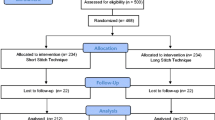Abstract
Background
Within the last decade the customary trend of using non absorbable sutures has changed, with numerous studies and meta-analyses advocating the use of slowly absorbable sutures, claiming comparable wound strength with significantly lower incidence of wound complications. It was the objective of this randomized clinical trial to compare two universally accepted suture materials, the non-absorbable Nylon and the slowly absorbable Polydioxanone for midline abdominal closure in the Indian context.
Method
64 patients undergoing midline laparotomy were allocated, using block randomization, to mass closure of the abdominal wall with continuous polyamide (34 patients) or continuous polydioxanone (30 patients).
Results
There was an alarmingly higher incidence of wound dehiscence in the PDS group requiring secondary suturing (Nylon 0; PDS 5). Mid-way through the trial, an interim analysis was performed which revealed an unacceptably high incidence of wound dehiscence in the PDS group. This necessitated a premature curtailment of the study. There was, however, a statistically significantly higher incidence of scar pain in the Nylon group (Nylon 9; PDS 1).
Conclusion
There is a need for a study with larger series, and PDS as a choice of suture for midline wound closure cannot be recommended.
Similar content being viewed by others
References
Weiland DE, Bay RC, Del Sordi S (1998) Choosing the best abdominal closure by meta-analysis. Am J Surg 176:666–670
Ceydeli A, Rucinski J, Wise L (2005) Finding the best abdominal closure: an evidence-based review of the literature. Curr Surg 62(2):220–225
Krukowski ZH, Cusick EL, Engeset J et al. (1987) Polydioxanone or polypropylene for closure of midline abdominal incisions: a prospective comparative clinical trial. Br J Surg 74:828–830
Riet M, Steyerberg EW, Nellensteyn J et al. (2002) Metaanalysis of techniques for closure of midline abdominal incisions. Br J Surg 89:1350–1356
Rucinski J, Margolis M, Panagopoulos G et al. (2001) Closure of the abdominal midline fascia: meta-analysis delineates the optimal technique. Am Surg 67(5):421–426
Wissing J, van Vroonhoven TJ, Schattenkerk ME et al. (1987) Fascia closure after midline laparotomy: results of a randomized trial. Br J Surg 74(8):738–41
Meunier JK, Mangan CE (2003) Running Mass Closure Using Looped Polydioxanone Suture in a High-Risk Population. J Gynaecol Surg 19(4):157–160
Chowdhury SK, Choudhury SD (1994) Mass closure versus layer closure of abdominal wound: a prospective clinical study. J Indian Med Assoc 92(7):229–232
Bender JS (2003) Factors influencing outcome in delayed primary closure of contaminated abdominal wounds: a prospective analysis of 181 consecutive patients. Am Surg 69(3):252–255
Bellon JM, Rodriguez M, Serrano N et al. (2005) Polypropylene and polydioxanone show similar biomechanical efficacy in midline closure. Cir Esp 78(6):377–381
Gys T, Hubens A (1989) A prospective comparative clinical study between monofilament absorbable and non-absorbable sutures for abdominal wall closure. Acta Chir Belg 89(5):265–2670
Israelsson LA, Jonsson T (1994) Closure of midline laparotomy incisions with polydioxanone and nylon: the importance of suture technique. Br J Surg 81(11):1606–1608
Carlson MA, Condon RE (1995) Polyglyconate (Maxon) versus nylon suture in midline abdominal incision closure: a prospective randomized trial. Am Surg 61(11):980–983
Hodgson NCF, Malthaner RA, Ostbye T (2000) The search for an ideal method of abdominal fascial closure: a metaanalysis. Ann Surg 231:436–442
Leaper DJ, Allan A, May RE et al. (1985) Abdominal wound closure: a controlled trial of polyamide (nylon) and polydioxanone suture (PDS). Ann R Coll Surg Engl 67(5):273–275
Ellis H, Gajraj H, George CD (1983) Incisional hernias: when do they occur? Br J Surg 70(5):290–291
O’Dwyer PJ, Courtney CA (2003) Factors involved in abdominal wall closure and subsequent incisional hernia: a randomized study. Surg JR Coll Surg 7–22
Author information
Authors and Affiliations
Corresponding author
Rights and permissions
About this article
Cite this article
Gaikwad, V., Kapoor, R. & Thambudorai, R. An ideal suture for midline abdominal closure?. Indian J Surg 71, 128–132 (2009). https://doi.org/10.1007/s12262-009-0036-1
Received:
Accepted:
Published:
Issue Date:
DOI: https://doi.org/10.1007/s12262-009-0036-1




